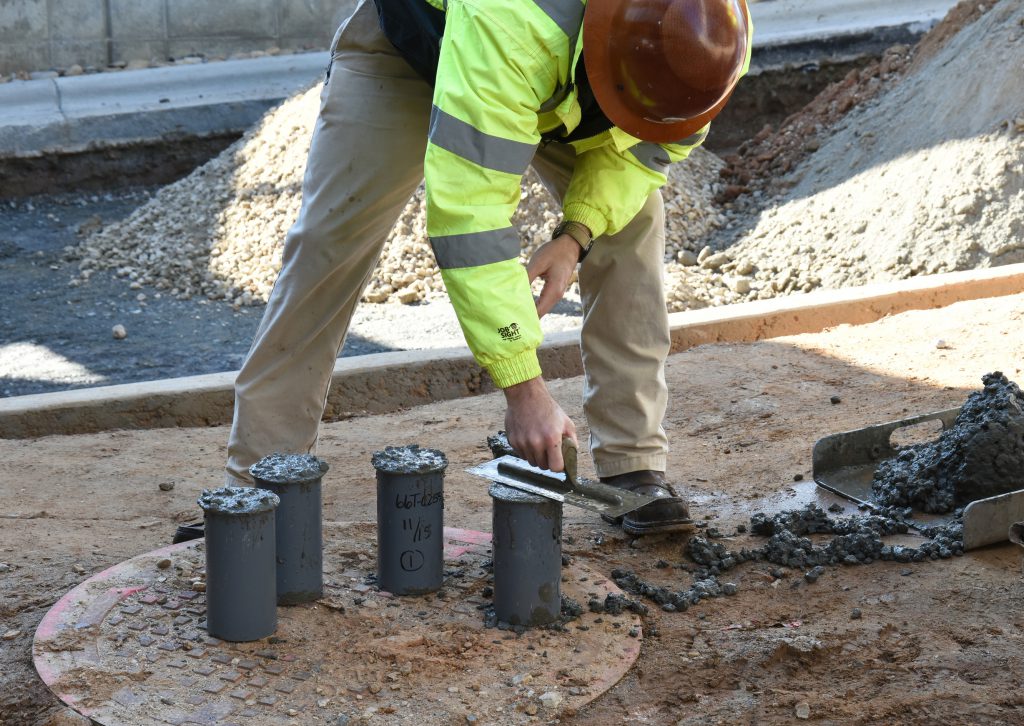9 Easy Facts About Material Testing Labs Explained
Wiki Article
Material Testing Labs for Beginners
Table of ContentsAll About Material Testing Labs5 Easy Facts About Material Testing Labs DescribedSome Known Incorrect Statements About Material Testing Labs Examine This Report about Material Testing LabsThe Only Guide to Material Testing LabsMaterial Testing Labs Fundamentals Explained
Initial setting time is defined as the duration as elapsing between the time when water is included in the cement and the time at which the needle of 1 mm2 section fails to penetrate the test block to a depth of concerning 5 mm from the base of the mold and mildew.Various other examinations carried out on fresh concrete are: Segregation resistance, Unit weight, Wet evaluation, Temperature level, Warmth generation, Hemorrhaging The most common quality examinations on hard concrete are: The examination of compressive stamina of the concrete cube gives a suggestion concerning all the residential or commercial properties or qualities of the concrete. The test of tensile toughness of the concrete is just one of the fundamental & essential homes which primarily impact the level & size of cracking in frameworks.
It is essential to figure out the tensile strength of concrete to figure out the load at which the concrete members might crack. The modulus of elasticity of concrete is the proportion of stress to the stress of the concrete under the application of lots.
Everything about Material Testing Labs
As one of the most commonly secondhand materials in building and construction, concrete needs rigorous quality assurance to ensure its stamina as well as lasting efficiency. The toughness will certainly rely on many factors, including water-cement ratio, quality of materials and quality assurance during the production of concrete. Below are three common concrete tests that help to ensure it meets the required standards and design requirements for its usage.
In 3 layers, the cone is loaded with the fresh concrete example in a consistent manner. Each layer is tamped with a steel rod to portable the concrete. material testing labs. Once filled, any overflow is gotten rid of, and the concrete is levelled. The cone is then gradually and also progressively raised and also placed inverted next to the depression.
Unknown Facts About Material Testing Labs
The concrete ought to mostly maintain its cone shape, demonstrating that the mix is cohesive, and also its workability isn't too expensive. The compressive strength of concrete a common efficiency action made use of by designers to make structure as well as other structures. Compressive strength is defined as the ability of the concrete to withstand specific compressive pressures.In a research laboratory, you can gauge the compressive stamina of the concrete utilizing highly controlled cylindrical moulds. Just how it functions Concrete samples are placed right into the cyndrical tubes determining 200mm high and 100mm in size (AS 1012. 9) on-site. When dried, say the following day, they are then carried to the lab, de-moulded and positioned into a curing container.
Drying shrinking happens when the concrete framework agreements due to moisture/water loss. This can detrimentally influence the longevity, aesthetic appeals, and also use of concrete frameworks.
More About Material Testing Labs
Just how it functions Samples are cast right into moulds as well as stored in a moist atmosphere till solidified. The concrete examples are then de-moulded as well as positioned in lime saturated water baths and afterwards a drying out chamber throughout of the examination. The initial reading is determined at 7 days from time of spreading.Damaging examinations (DT) and also (DT) are the examinations done on hard concrete. Concrete is the oldest as well as crucial building and construction material on the planet. Evaluating of the concrete plays an important role to understand the strength, longevity as well as problem of the structure. This post is about the kinds of Damaging as well as non-destructive examinations done on concrete.
Devastating examinations and also Non-Destructive tests are done to establish the crucial homes of concrete like compressive stamina, flexural strength, over here tensile stamina etc. The top quality of concrete is essential for construction. Solidified concrete attains strength as it matures. The devastating examination of concrete aids to comprehend the behaviour and also quality by breaking the test specimen at certain lots.
The Greatest Guide To Material Testing Labs
The damaging testing technique appropriates and economically helpful for the concrete samplings that are generated at a large scale. The main objective of harmful examinations is to explore the solution life and also detect the weakness of design that might not show under normal working conditions. It includes methods where the concrete sampling is broken so regarding establish mechanical homes i..jpg/:/cr=t:0%25,l:0%25,w:100%25,h:100%25/rs=w:400,cg:true)
Quality control, Acceptance of concrete, Analysis of curing, To supply details on making use of sand as well as accumulation. For assessing the harmony of concrete, Price quotes the concrete quality with common needs. To identify the uniform anxiety circulation. Examining the behavior of concrete. For establishing the in-place concrete strength. material testing labs. Age of concrete, etc.
These examinations identify the compressive, flexural and tensile toughness of concrete. There are different sorts of examinations offered to examine the hard concrete. They are as complies with. Compressive strength of concrete is the capacity of the concrete to endure loads without splitting or deformation. The More about the author concrete sampling to conduct this examination ought to be either round or cubic.
The pertinent IS code for this test is IS 516-1959. The tons at which the specimen stops working gauges its stamina. The device of compressive strength of concrete is N/mm2. The examination should be done at 7, 14 & 28 days. The splitting tensile stamina examination is one of the examinations on hardened concrete for identifying its tensile toughness.
Report this wiki page